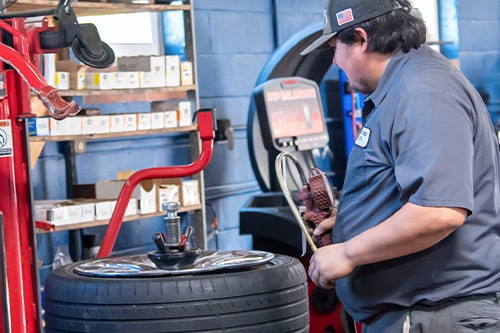Tire rotation involves relocating tires from one position to another on a vehicle. The rotation pattern varies depending on whether your vehicle is front-wheel drive, rear-wheel drive, or four-wheel drive. This process combats uneven wear, and it’s recommended to rotate your tires every 5,000 to 7,500 miles.
A suitable time frame for tire rotation is during your routine oil change. If you detect uneven wear due to suspension or alignment issues, rotate the tires after addressing the problem, even if you’ve recently rotated them. For both tire rotation and balancing, trust Kanuga Tire & Auto in Hendersonville, NC.

Even when a vehicle’s wheels are properly aligned, each tire experiences wear at a different rate. This differential wear can be attributed to multiple factors, among which are the weight distribution of the vehicle and the position of the drive tire(s). For many vehicles, the engine’s front placement results in the front being heavier, leading to accelerated tire wear in that region.
Rear-wheel drive vehicles might feature one or two main drive tires, often referred to as “one wheel peel” or “positraction.” These are the tires responsible for propelling the vehicle forward, whereas the remaining tires are simply free-wheel. Consequently, drive wheels undergo more wear. In contrast, vehicles with front-wheel drive utilize both front tires as drive wheels.
Given these different drive configurations, it’s essential to recognize that each necessitates its distinct tire rotation pattern.
For rear-wheel drive configurations, a rearward cross pattern is employed during tire rotation. This means that the rear tires remain on their respective sides but are moved to the front. Specifically, the left front tire shifts to the right rear position, while the right front tire is relocated to the left rear.
For vehicles equipped with either four-wheel or all-wheel drive, an X pattern is used for rotation. Here, the left front tire moves to the right rear and vice versa. Similarly, the right front tire is positioned to the left rear, and the left rear tire takes its place at the right front.
For vehicles with front-wheel drive configurations, the forward-cross rotation pattern is recommended. In this pattern, the front tires are moved directly to the rear on the same side. The left rear tire is shifted to the right front position, while the right rear tire is relocated to the left front.
When you have a full-size spare tire, it’s advisable for your tire technician to include it in the rotation, particularly for four-wheel drive vehicles. Additionally, if your vehicle is equipped with directional or high-performance tires, the rotation patterns may vary slightly.
You already know that no tire wears the same as the other tires on the vehicle. That is the biggest reason to rotate the tires at every 5,000 to 7,500 miles. Tire rotation also provides additional benefits, including enhancing the safety of the vehicle, as follows:
Balancing your vehicle’s tires is crucial. If the tires are not balanced, you’ll typically notice a vibration in the steering wheel between 50 and 75 mph. Unbalanced tires shimmy on the road, leading to increased tire wear. Furthermore, unbalanced tires pose a safety risk as they bounce excessively.
Tires can become unbalanced if one of the weights falls off, or if you knock it off by hitting a pothole too hard or brushing against a curb.
Even if you believe the tires are balanced, it’s advisable to have a tire technician check the balance at least once a year or every 6,000 to 8,000 miles, whichever comes first. This interval aligns well with the recommended tire rotation schedule, allowing for both services to be performed concurrently, ensuring optimal tire performance and longevity.
Keep your vehicle running smoothly and safely with the comprehensive maintenance services at Kanuga Tire & Auto. Whether you need tire rotation, balancing, or any other auto care, our skilled technicians are dedicated to meeting your needs. Schedule your appointment today at (828) 697-2860 or visit us at our convenient location at 423 Kanuga Road, Hendersonville, NC 28739. We look forward to serving you and ensuring your vehicle is in peak condition!
visibility_offDisable flashes
titleMark headings
settingsBackground Color
zoom_outZoom out
zoom_inZoom in
remove_circle_outlineDecrease font
add_circle_outlineIncrease font
spellcheckReadable font
brightness_highBright contrast
brightness_lowDark contrast
format_underlinedUnderline links
font_downloadMark links